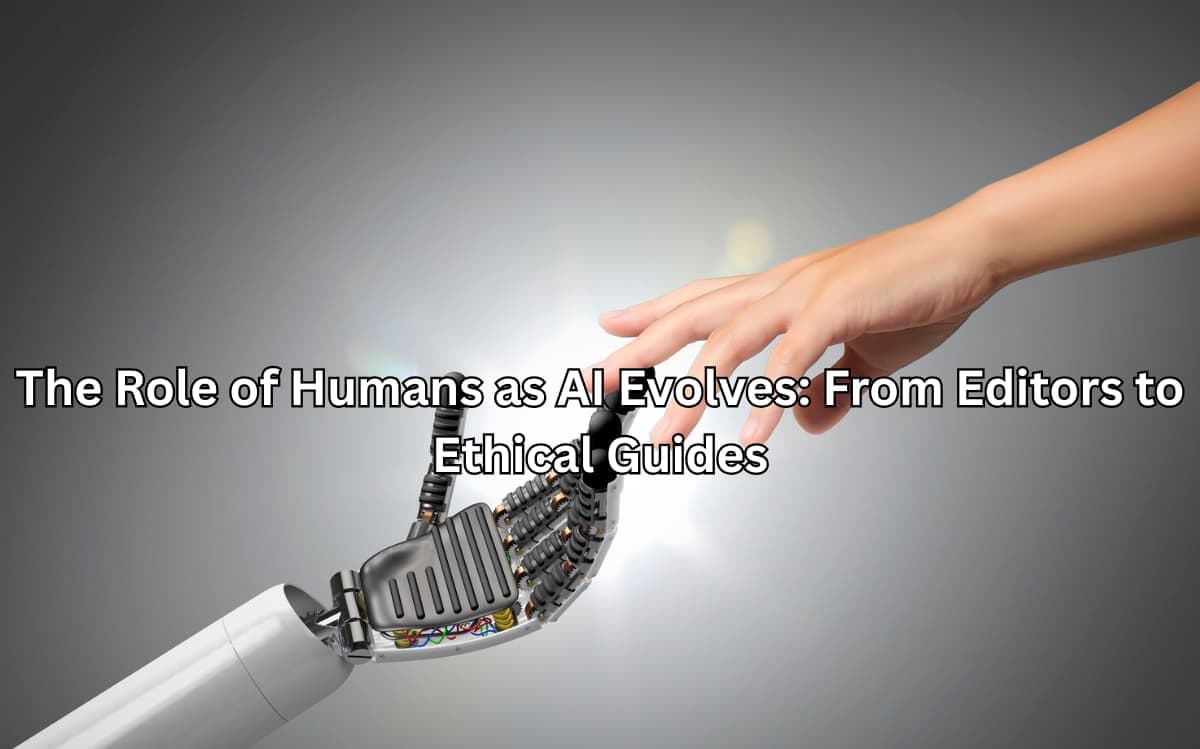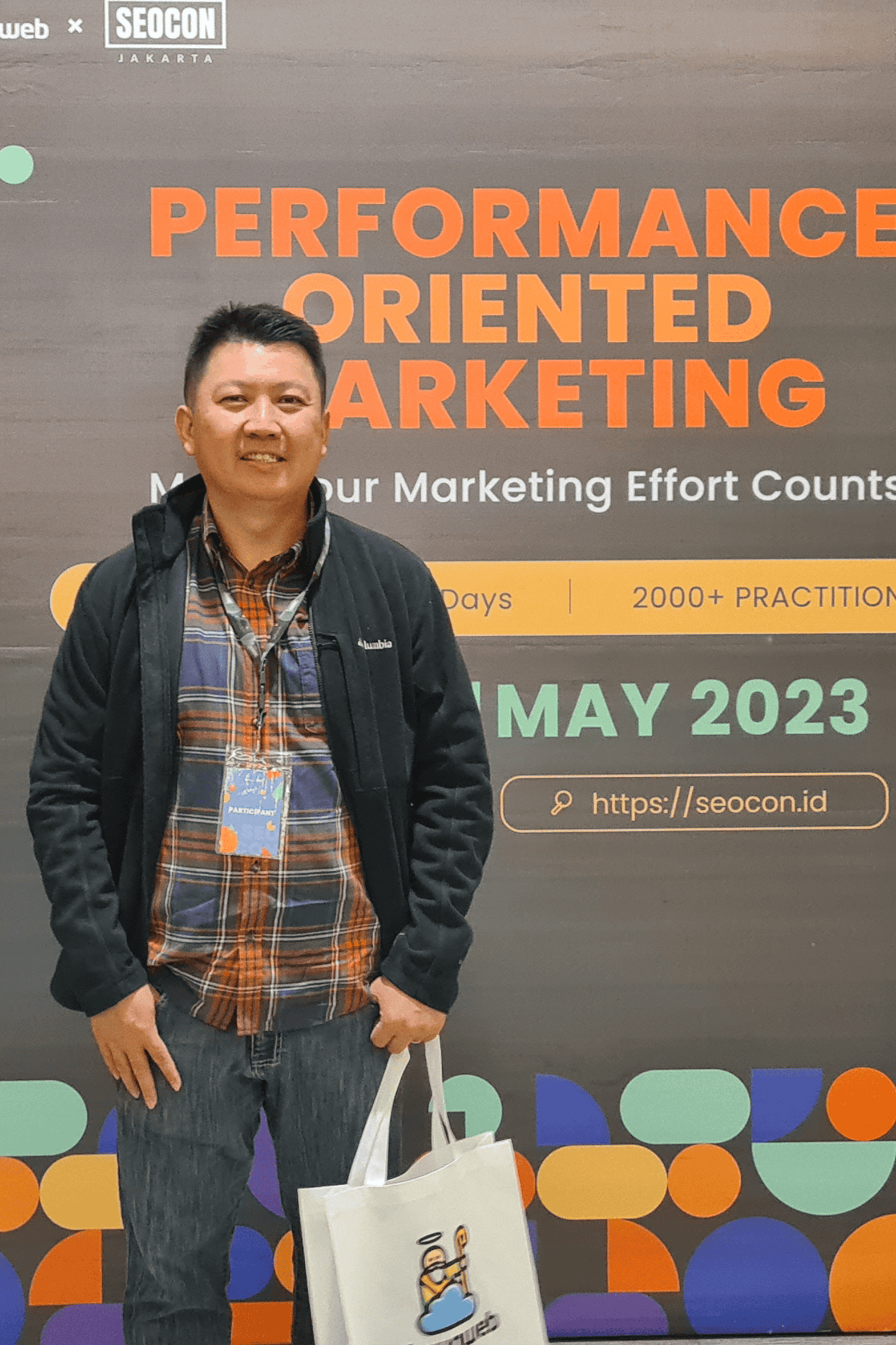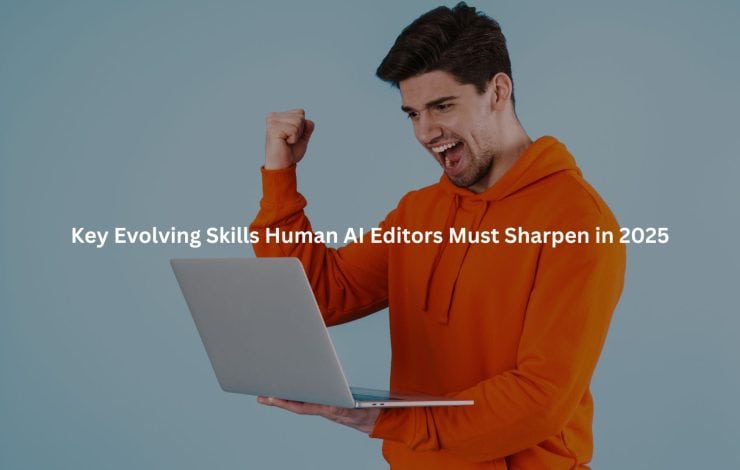As AI weaves itself into our work, our role as content editors is changing, and honestly, it’s for the better. We’re no longer just the people who catch typos or rewrite clunky sentences.
Our job has been promoted. We are now the strategic guides, the quality controllers, and the essential human touch that turns machine-generated text into something truly valuable. [1]
We’ve moved from being in the weeds of content creation to overseeing the entire landscape, ensuring every piece of content is not just correct, but resonant and responsible. So, what does this new reality look like for us? Let’s explore our evolving part in this new era.
Key Takeaways
- Our Jobs Aren’t Gone, They’ve Been Promoted: We’ve shifted from hands-on creators to strategic curators, guiding AI to produce high-quality work that aligns with larger goals.
- We’re the Guardians of What Makes Content Human: We provide the essential emotional intelligence, ethical judgment, and nuanced understanding that AI simply cannot replicate.
- It’s Not Us vs. The Machine; It’s a Partnership: The most powerful content comes from a hybrid system where we leverage AI for speed and scale while we provide the critical thinking and creative spark.
The New Job Description: From Wordsmith to AI Coach
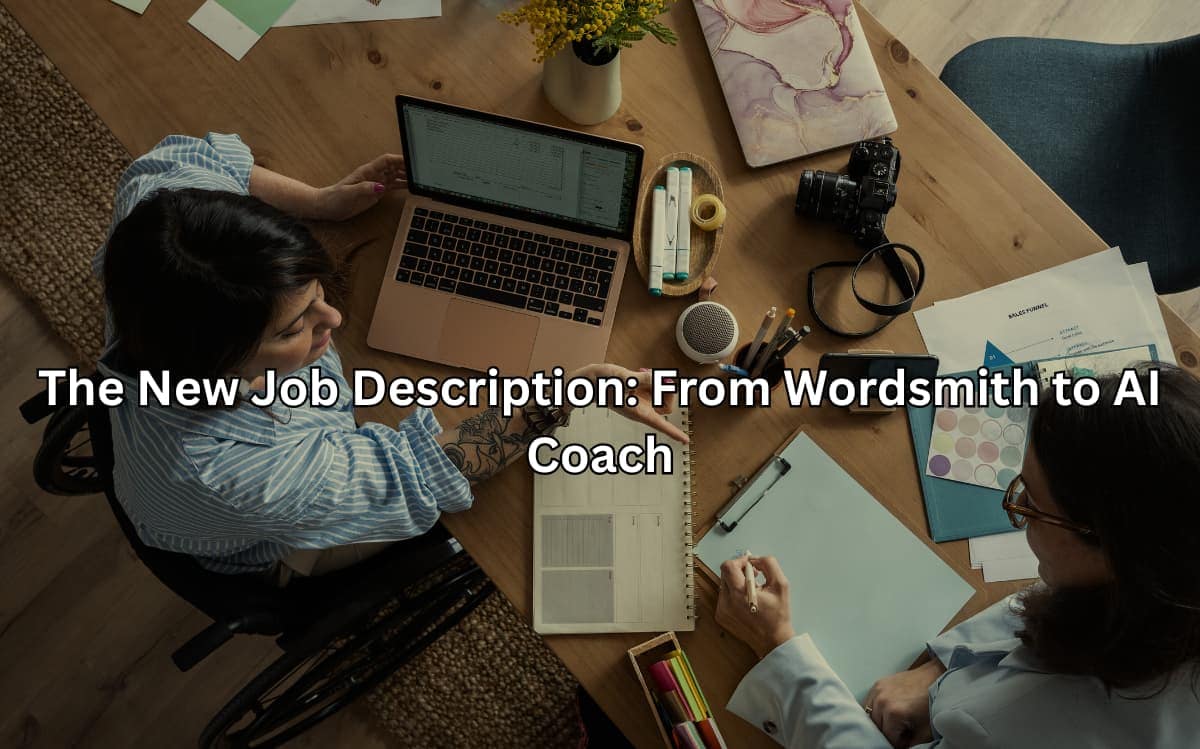
For years, the rhythm of our work was familiar: writing, rewriting, and meticulously proofreading. It was a hands-on craft. When we first started integrating AI into our content workflows at Jet Digital Pro, there was a real sense of uncertainty in the room. Were we training our replacements? We quickly discovered the answer was a resounding no. The tool didn’t replace us; it challenged us to work smarter.
Our role began to morph from the craftsperson at the workbench to the director in the studio. Instead of spending hours on a first draft, we now invest that time in crafting detailed, insightful prompts. This isn’t just typing a question; it’s a disciplined creative process. We have to think deeply about:
- Who we’re talking to: What are their actual problems? What tone will make them listen?
- What we need to say: What’s the core message? How can we build an argument that sticks?
- How it should sound: Does this reflect our personality and values?
- What we want to achieve: What action should this content inspire? Where does it fit in our client’s strategy?
The AI generates the text, but we provide the soul. We’re the ones who step back and ask the tough questions. Is this factually sound? Is the logic solid? Can we make a stronger emotional connection? This evolution is less about manual editing and more about cognitive oversight.
We are teaching, guiding, and elevating the AI’s output, becoming its most important human collaborator. This is the new reality of human-AI collaboration in editing, where our experience and judgment have become our most valuable assets.
The Uniquely Human Touch: Our Irreplaceable Value
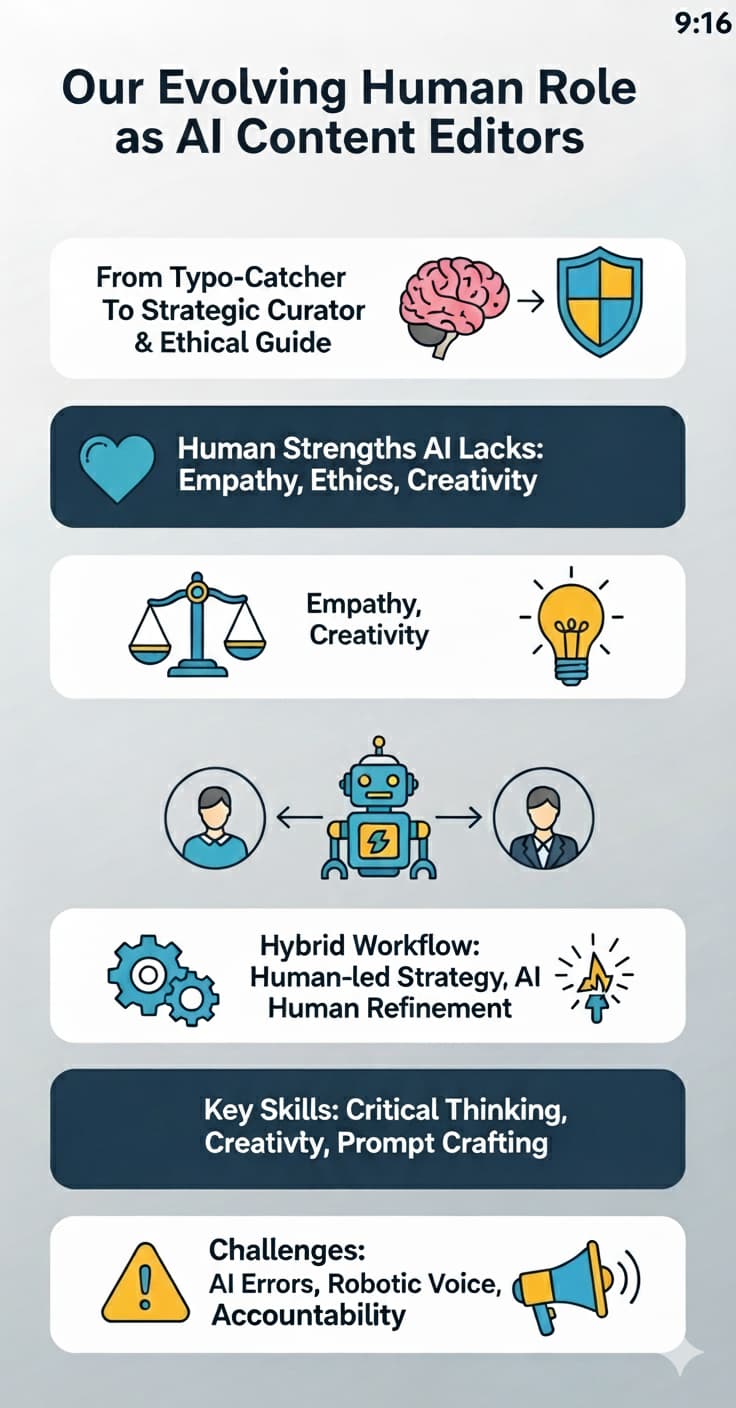
While AI can process data and spit out coherent sentences at an incredible pace, it has no life experience. It doesn’t understand hope, fear, or the nuance of a well-timed joke. This is where we come in, adding the essential layers that transform generic text into compelling, trustworthy content. We’ve learned that our most vital work falls into a few key areas that AI can’t touch. [2]
Our role has solidified around being the guardians of quality and integrity. This means we are:
- The Ethical Filter: AI models learn from the internet, which is full of hidden biases. We are the essential human filter, responsible for spotting and removing biased language, unfair assumptions, and harmful stereotypes. We ensure content is inclusive and responsible, protecting both the audience and the brand.
- The Keepers of the Brand Voice: A brand’s voice is its personality. An AI can mimic it, but it often misses the subtleties. We make sure every piece of content, from a blog post to a technical guide, feels authentic and consistent, maintaining that hard-won trust with customers.
- The Masters of Empathy: People connect with content that makes them feel something. We read an AI draft and ask, “How will this land with a real person?” We then adjust the language, add a relatable story, or reframe a point to create a genuine emotional connection. This is the difference between content that simply informs and content that truly influences.
- The Interpreters of Context: The world is complex. Language is filled with cultural references and subtle meanings that an algorithm can easily misinterpret. We bring a deep understanding of context, preventing embarrassing mistakes and ensuring the message is received exactly as intended.
This shift means that the skills we value most have changed. It’s less about typing speed and more about critical thinking, creativity, and emotional intelligence. This directly impacts the job outlook for human-AI editors, placing a premium on uniquely human abilities.
The Power of Partnership: Building a Hybrid Content Engine
Credits: Yuval Noah Harari
The most effective approach we’ve found is to stop thinking in terms of “human vs. machine.” The real magic happens when we build a hybrid system where our human intelligence and artificial intelligence work together, each playing to its strengths.
We like to think of it like a top chef running a kitchen. The AI is our team of incredibly efficient sous chefs. It can handle the prep work, researching, outlining, drafting, and checking for basic errors, with breathtaking speed.
This frees up the chef (us, the human editor) to focus on what really matters: the creative vision, the blend of ideas, the final presentation, and the unique flair that makes the content exceptional.
In our daily workflow, this partnership looks like this:
- Human-Led Strategy: We start with the “why.” We define the goals, research the audience, and map out the core message.
- Human-Guided Prompting: We translate that strategy into a detailed creative brief for the AI, giving it clear direction on everything from tone to keywords.
- AI-Assisted Drafting: The AI takes over the heavy lifting, generating a solid first draft in a fraction of the time it would take a human.
- Human Refinement and Elevation: Here’s where we shine. We take that raw output and elevate it. We fact-check everything, deepen the insights, add our own experiences or examples, and rewrite sections to make them sing. We ensure the final piece isn’t just “good enough” but great.
This collaborative model creates a powerful feedback loop. We get better at prompting, and the process becomes smoother and more effective over time.
The AI gives us scale, and we provide the quality assurance and strategic thinking. This synergy is at the heart of the future of human-AI content editors.
Making it Work in Practice: Overcoming the Challenges

Bringing AI into an established workflow wasn’t as simple as flipping a switch. It came with some real on-the-ground challenges.
One of the first things we learned is that AI sounds incredibly confident, even when it’s wrong. We had to quickly instill a “trust, but verify” culture, where every fact and claim is rigorously checked against reliable sources.
Are You a Digital Agency?
White Label SEO Content Services for Agencies
Scalable, customizable, and results-driven content solutions for your clients.
Another hurdle was fighting the “AI voice.” Without a firm hand, AI-generated content can sound bland and robotic. To counter this, our editors have become experts at injecting personality. We’re ruthless about cutting out generic phrasing and weaving in human stories and a distinct point of view.
Finally, we had to address accountability. If an error slips through, who’s responsible? Our answer is simple: we are. The human editor is always accountable for the final product.
The AI is a powerful tool, but we are the ones who are ultimately in control. This principle of human oversight is non-negotiable. It’s how we maintain our standards and build lasting trust with our clients and their audiences.
Frequently Asked Questions
Will AI take over editing jobs?
No, AI is changing editing jobs, not eliminating them. Instead of only fixing mistakes, people now guide the AI. They use their creativity and judgment to improve the AI’s writing, turning it into high-quality content. It’s more of a team effort where the human is the leader.
What do human editors do that AI can’t?
Humans understand feelings, humor, and culture in a way that AI cannot. They make sure writing has a personal touch and is fair to everyone. They also use their real-world experience to check facts and ensure the final content is trustworthy, accurate, and makes sense.
How do humans and AI work together on content?
It’s a partnership. A person starts with a clear idea and strategy. The AI then helps write a fast first draft. Afterward, the human editor takes that draft and adds creativity, checks all the facts, and refines the text to make sure it truly connects with readers.
Why is a human still needed to check AI writing?
Need a Strategic SEO Content Partner?
Let’s craft SEO content that ranks, converts, and grows your brand.
Talk to UsAI can make mistakes, miss context, or sound very robotic. A human is needed to catch these errors and add personality and a natural flow. They also ensure the writing is ethical and doesn’t contain hidden biases, which is very important for building trust with an audience.
What skills do editors need to work with AI?
Editors now need to be excellent thinkers and strategists. Instead of just focusing on grammar, they need to be good at giving clear instructions to AI. Skills like critical thinking, creativity, and understanding how to guide technology are becoming more important than ever for this new role.
Our Human Future Alongside AI
Our journey with AI has shown us that our role as content professionals isn’t fading, it’s getting more interesting and more important. We’re shifting away from repetitive tasks and focusing our skills on what we do best: strategy, creativity, critical thinking, and ethical judgment.
Our future isn’t a battle against technology but a partnership with it. We are the essential human element that gives AI-powered content its purpose, integrity, and soul. As the tools evolve, so will we, growing into our new roles as the conductors of this powerful collaboration.
If you’re looking to build a content engine that combines the best of human expertise and AI efficiency, we should talk. Contact us at Jet Digital Pro to learn how our hybrid approach can work for you.
References
- https://www.harvardbusiness.org/insight/ai-first-leadership-embracing-the-future-of-work/
- https://mitsloan.mit.edu/press/humans-and-ai-do-they-work-better-together-or-alone
Related Articles
- https://jetdigitalpro.com/future-of-human-ai-content-editors/
- https://jetdigitalpro.com/human-ai-collaboration-in-editing/
- https://jetdigitalpro.com/job-outlook-for-human-ai-editors/
P.S – Whenever you’re ready,
we’re here to help elevate your SEO content.
Partner with us for strategic, scalable content that drives real organic growth.
Contact Us Now
